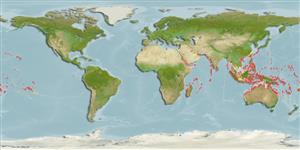Environment: milieu / climate zone / Tiefenbereich / distribution range
Ökologie
seewasser riff-verbunden; tiefenbereich 0 - 23 m (Ref. 58302), usually 1 - 3 m (Ref. 58302). Tropical; 30°N - 33°S, 26°E - 124°W
Indo-Pacific: Red Sea and East Africa (Ref. 5470) to the Marquesan Islands and Mangaréva, north to southern Japan and the Hawaiian Islands, south to the Kermadec and Rapa Islands.
Size / Gewicht / Alter
Geschlechtsreife: Lm ? range ? - ? cm
Max length : 30.0 cm TL Männchen/unbestimmt; (Ref. 9947); common length : 23.0 cm TL Männchen/unbestimmt; (Ref. 9947)
Rückenflossenstacheln (insgesamt) : 10; Rückenflossenweichstrahlen (insgesamt) : 11; Afterflossenstacheln: 3; Afterflossenweichstrahlen: 6. Light brown, whitish below, with white and dark brown spots (Ref. 5469).
Body shape (shape guide): fusiform / normal; Cross section: oval.
Inhabits reef fronts and rocky shorelines exposed to moderate to strong surge to depths of about 3 m (Ref. 9947). Benthic (Ref. 58302). Feeds primarily on crabs, also takes other crustaceans, small fishes, sea urchins or brittle stars. Marketed fresh (Ref. 9947).
Life cycle and mating behavior
Geschlechtsreife | Fortpflanzung | Ablaichen | Eier | Fecundity | Larven
Pelagic spawner (Ref. 31569). Spawning ascents into the water column occurred over a distance of 1.5 to 2.0 m (Ref. 26305). Further histological evidence is needed to establish protogyny (Ref. 103751).
Randall, J.E., G.R. Allen and R.C. Steene, 1990. Fishes of the Great Barrier Reef and Coral Sea. University of Hawaii Press, Honolulu, Hawaii. 506 p. (Ref. 2334)
IUCN Rote Liste Status (Ref. 130435: Version 2025-1)
Bedrohung für Menschen
Harmless
Nutzung durch Menschen
Fischereien: kommerziell; Sportfisch: ja; Aquarium: Kommerziell
Tools
Zusatzinformationen
Download XML
Internet Quellen
Estimates based on models
Preferred temperature (Ref.
123201): 24.7 - 29.3, mean 28.2 °C (based on 2984 cells).
Phylogenetic diversity index (Ref.
82804): PD
50 = 0.5625 [Uniqueness, from 0.5 = low to 2.0 = high].
Bayesian length-weight: a=0.00933 (0.00385 - 0.02260), b=3.08 (2.87 - 3.29), in cm total length, based on LWR estimates for this (Sub)family-body shape (Ref.
93245).
Trophic level (Ref.
69278): 3.7 ±0.3 se; based on diet studies.
Fishing Vulnerability (Ref.
59153): Low vulnerability (20 of 100).
🛈
Nutrients (Ref.
124155): Calcium = 61.8 [39.8, 90.9] mg/100g; Iron = 0.662 [0.430, 1.056] mg/100g; Protein = 19.2 [18.2, 20.1] %; Omega3 = 0.135 [0.095, 0.192] g/100g; Selenium = 30.2 [18.5, 49.0] μg/100g; VitaminA = 78.4 [31.3, 198.1] μg/100g; Zinc = 1.41 [1.04, 1.86] mg/100g (wet weight);
